History of the Parish
The Church of the Holy Child is first mentioned in the Irish Catholic Directory in 1942 as a Chapel of Ease in the Parish of Glasnevin.
The Church of the Holy Child is first mentioned in the Irish Catholic Directory in 1942 as a Chapel of Ease in the Parish of Glasnevin. The Parish Church was that of Our Lady of Dolours in Glasnevin and Corpus Christi was a second Chapel of Ease in that Parish. In 1944 Holy Child became a Parish in its own right. The actual Church of the Holy Child was a temporary structure known as the ‘Tin Church’ and was situated on the Green at Larkhill. The Parish was known as Larkhill Parish. The present Church of the Holy Child was blessed on Sunday, 1st December 1957 by the late Most Rev. Dr. McQuaid, Archbishop of Dublin. The Church with accommodation for over 1750 people, was build in red brick with granite dressings and cost £170,000.
The Parish has well over 7,000 homes with a population in excess of 20,000. A striking feature of the Church interior is its soaring ceiling with its semi-domes and the high nave arcades with their columns encased in pale fawn marble. The chancel measured 68 feet by 32 feet and there is a very fine statue in each of the transepts. A more recent addition is a large painting of the Last Supper by Tom Roche, mounted above the main Altar. The nave and aisles have a span of 58 feet and overall length is 222 feet. The belfry is 100 feet high and is detached from the Church and Lombardic tiles. The first Parish Priest of Larkhill/Whitehall was Very Rev. Canon Keane and he was here until 1961. He lived at 132 Iveragh Road. Very Rev. Bernard Brady succeeded him and was the first to move into 181, Swords Road. At this time the Parish was very large and included Ballymun and Santry. St Pappin’s Church on Ballymun Road (now a nursing home) and Our Lady of Victories Hall were Chapels of Ease in the Parish. In 1968 the Parish of Ballymun was constituted with Our Lady of Victories as the Parish Church. Fr. Brady then became Parish Priest of Our Lady of Victories and Rev. John Menton took over Larkhill/Whitehall. Ballymun Parish was later divided with the formation of Sillogue Parish 1972 and Balcurris in 1975. Fr. Menton died in 1976 and was buried in the grounds of the Church of the Holy Child. Fr. Brady died in 1987 and was buried in the grounds of Our Lady of Victories.
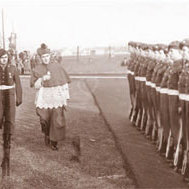
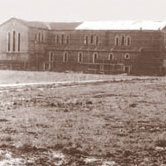
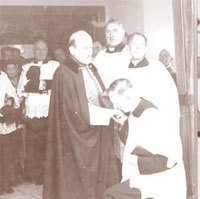
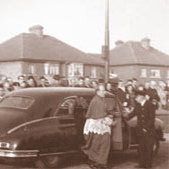
In October 1976 Bishop James Kavanagh was appointed Parish Priest. Now deceased, he lived at 181, Swords Road. In 1985 Mgr. Owen Sweeney was appointed Parish Priest and remained here until 1992 when he became a curate (at his own request) in Tallaght. The next Parish Priest was Fr. Joe Kelly who came to the Parish from Finglas in 1992. He became a curate (at his own request) in Bayside. Fr. John Fitzpatrick then came as Parish Priest to the Parish from Westland Row and remained until 2006 when he moved to Sutton.
Among the number of notable events which took place in the parish were :
A large prayer meeting for peace took place in Ellenfield Park in 1974.
A pilgrimage took place from the Parish which travelled to Rome for the canonisation of Oliver Plunkett.
In October 1978 the first European T.V. Mass was broadcast from the Church. The Chieftains together with the Parish Choir provided the music.
On the 11th April 1979, the Organum Choir of Poland, of which Pope John Paul II was patron, sang in the Church.
The Legion of Mary first started in the Parish in 1946 and its first president was Joe McAllister who later became Fr. Joe McAllister C.M. R.I.P.
In July 1970, Sr. Fidelma O’Neill from Coolatree Park, made her final Religious Profession as a Franciscan Missionary Sister. This was the first religious profession celebrated in this Church. Pat O’Donoghue from the parish and now Director of the Diocesan Liturgical Resource Centre and Diocesan Director of Music, was ordained on 6th June 1980.
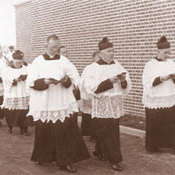
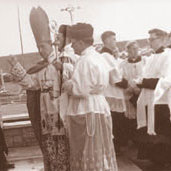
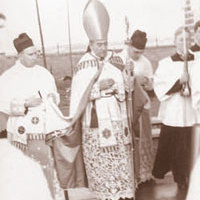
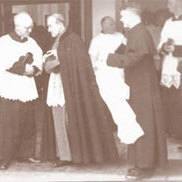
Michael Simpson from Lorcan Avenue was ordained a priest by Bishop James Kavanagh on June 12th 1992.
During the time Fr. John Fitzpatrick was Parish Priest a new Parish Center was added to the Church. The new center now up and running has a Parish Office,Meeting Rooms, Coffee Shop and a gleaming new kitchen catering for Meals-on- Wheels.
Fr.Michael Carey was appointed Administrator in 2006. The current Parish Priest is Fr. Robert Smyth.
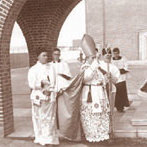
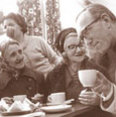
The Great North Road
Most of us at some stage during our days’ duties, will walk, drive or perhaps cycle up the Swords Road. Next time you do, however, it may be worthwhile to take a moment to think of the fascinating history that belongs to the “Great North Road.”
Most of us at some stage during our days’ duties, will walk, drive or perhaps cycle up the Swords Road. Next time you do, however, it may be worthwhile to take a moment to think of the fascinating history that belongs to the “Great North Road.”
So like many a weary traveller before us we will take a journey up one of the leading highways out of the city. Even going back as far as 1450 when it was known as “the Royal Way”, this road was regarded as an important route. Over the years it has grown both in size and importance. (And you thought it was just a quick route to the Omni!)
Let us begin our walk beyond the Parish boundaries atWhitehall Garda Barracks; it is approximately between the barracks and Home Farm Football Club that “Whitehall House” once stood. This is the house that gave its name to the district in the early part of the last century. Before this adoption of the name “Whitehall,” the area was known as “Clonturk.” On our way into the Parish we see the Regency Hotel on the right and just beyond this we pass Highfield a private hospital. Opposite Highfield is Plunket College which like the Church of the Holy Child sees 2007 as a special year. This year the College celebrates forty years of educational provision in our Parish.

Where the houses now stand between Plunket College and the Viscount Public House there once stood “Clonturk Castle”. Just beyond, we can see the entrance to Gaeltacht Park on our left. This was one of the first housing estates built in 1930 and it was envisaged by Eamon DeValera to house Irish Speaking Civil Servants, hence the Gaeltacht names on each of the roads – Tourmakeady, Innishmaan etc. Further on we come to the large intersection of Swords Road and Collins Avenue. Collins Avenue was built in 1938 to replace a dirt-track known as “Puckstown Lane.” Just beyond this, turning right onto Collins Avenue was a Public House called The Thatch and not too far from this was another Public House called The Black Bull. Both Public Houses can be found on maps dating back to 1938.
Of course we also have the Dublin Port TunnelWorks. Work started on this site in 2001. It is hoped that congestion along the city streets of Dublin will be reduced, as thousands of heavy goods vehicles gain fast toll- free access to Dublin Port. The official opening of Dublin Port Tunnel was December 20th, 2006.
Passing the CollinsAvenue junction we now stand with the Holy Child Church on our right. The Church was first mentioned in the Irish Catholic Directory in 1942. It was then a Chapel of Ease in the Parish of Glasnevin. It was not until 1944 that the Holy Child became a Parish in its own right. Behind the Church we find the estate of Ellenfield where once stood a house called “Clonturk Cottage” which was later renamed “Ellenfield House”. Here we also find Ellenfield Park beside the Church. Ellenfield Park can be found marked on maps from as far back 1860.
Behind the houses opposite the Church we find Larkhill housing estate. Not only was our original Church “the Tin Church” situated on Larkhill Green from 1942-1957 but the estate now houses the Holy Child Senior Girls’ School, The Holy Child Infants’ School and Larkhill Boys’ National School.
Returning to the Swords Road we are now facing the bridge over the motorway. The point where the bridge meets Shantalla Road was once known as “Cold Blow Harbour” where the Nanikan River passed. This river rose in the Crestfield area and then flowed into the sea at St. Anne’s in Raheny. It is possible that this river was once navigated as boats were present on the lakes in Santry Demesne. The Nanikan, later known as the Hollybrook Stream now flows under the motorway. Continuing on, we swiftly stop for a quick pick-me-up in the Comet Lounge Bar – but no dilly-dallying! There are years of history ahead!....
Onwards! Behind the Comet Public House we find the Shanowen and Shanliss area. Opposite the Comet we find the Larkhill and District Credit Union behind which lie the Shanvarna and Shanrath Roads. Further up opposite the entrance to Shanowen we find a group of cottages known as St. Canice’s Terrace. Shanowen itself was once the avenue leading to the “White House,” a grand 2 storey house built in the 1700s and last occupied in 1905.
Further on we find the Omni Shopping Centre where once stood McCairn’sMotors. McCairns shut its doors for the last time in 1987. The buildings were swiftly demolished and the 21 acre site put up for sale. The Omni Park Shopping Centre, a much needed Complex, opened in October 1991.
Still on the Swords Road or the Great North Road, it is clear just how large the Parish has become. We now travel past Magenta Hall, the old house is long gone, but its name is carried on in the name of the estate. We now pass the location of the new A.I.B. Bank on our left and we come to the Swiss Cottage on our right. We are now in Santry Village which was built for Lady Domville, the wife of Sir Charles Domville of Santry Estate. She had seen a similar village in northern Italy, had liked it and sent her architect to copy the plans of the houses. The forge and houses were built in 1848 - the old Forge with its traditional horse-shoe shaped door. (According to many the Forge faced the wrong way – west instead of the more traditional north). The forge had been operated by three generations of the Madden family from 1860 to its closure in the 1960s. A distinctive feature of the village in earlier years was the existence of turnstiles at different locations by means of which the inhabitants gained access to their homes. Before we were lucky enough to have our own National Schools in Larkhill, another National School existed in Santry, from 1850 – 1925. The lane where it once stood is still known as “Schoolhouse Lane” beside the Swiss Cottage.
Further on we come to St. Pappin’s, Church of Ireland which was built in 1709. The grounds of the Church contain the graves of many of the Domville family, their workers and tenants as well as the graves of one or two outlaws. In the 1800s Santry had an extremely high crime rate. Coaches were regularly held up by highwaymen. The North Road was notorious for highwaymen. One of the lawless incidents noted in the vicinity of Santry concerned an outlaw, who set up a line of dummy figures, each holding a rifle, to await the passing coach. The occupants of the coach frightened by the overwhelming odds were relieved of their valuables by Collier who was never caught and settled in a house bought with his ill-gotten gains (no Criminal Assets Bureau in those days!)
Now we come to what was at one time the epicentre of Santry. The history of Santry is intermingled with the history of its main estate. Originally owned by the Lord Barry of Santry, the Domvilles succeeded through intermarriage. The Domville family have what seems to be an inexhaustible supply of eccentric members with more money than wit. The stories that have been written about various members range from surprising to absurd. From generous donations of money to strangers, to mysterious meetings in the Hellfire Club, it seemed that with the Domvilles there was never a dull moment.
One very popular story is probably the most well known. Lady Margaret was late in preparing to go out with her husband Lord Charles. He became very angry and impatient for having been made wait and shot her favourite horse, “Abeian”. This is one account of the story, and there are many others. In all stories Lord Domville is immediately repentant for killing the animal and erected a stone monument in honour of the horse. This monument is well remembered by locals.
Today, on this land that was once owned by the Domvilles of Santry Court, Fingal County Council has created a magnificent park with beautiful walks and many fine trees remaining from the time of the Domvilles. The park, which also contains a river and the ruins of an old house, was opened in 2004 for the use of the people of Santry and surrounding districts. The Crowne Plaza Hotel is also built on land owned by Santry Court. This Hotel was opened in 2003 and contains 204 bedrooms and 25 meeting rooms. Also close by are Temple Gardens, where there are hundreds of luxury apartments. On this land we also have T.L.C. Nursing home which caters for many senior citizens and was opened on Monday 17th Jan 2005.
Opposite what were once the grand gates of Santry Demesne is the road to Coolock. As the parish grew to include new estates such as Oak Park, Royal Oak, Larch Hill and Aulden Grange it became apparent that the building of a Chapel of Ease to our own Church would be necessary. The result was the building of Blessed Margaret Ball. This Chapel was opened on 18th December 1994 and is now a vibrant part of our Parish.
Returning again to our original route up the Great North Road we now pass on our right Morton Stadium. Built on land which was also part of Santry Court the stadium facilitates many sporting events and was the brainchild of the late Billy Morton.
Further North is Turnapin which got its name from the Gaelic “Tor na Buinne”, meaning “the town of the pinnacle”.
Continuing forward we come to Dardistown Cemetery which opened in June 1990. The iron gates and stone pillars at the entrance previously stood at the entrance to St. Paul’s Cemetery on the Finglas Road and date back to 1860. The thatched cottage we see on the site has been restored and is being preserved.
So now we stand having walked through the Parish and through the years. It is now we think of the famous people who have travelled this road and passed our Church. In the early sixties, the first well known person to visit our Church was Cardinal Agaginian, the Papal Legate. He stopped to pray on his way from Dublin Airport on a visit to Archbishop John Charles McQuaid. The Cardinal was later mentioned as a possible candidate for the Papacy following the death of Pope John 23rd.
And who can forget the bright evening in June 1963 when the American President, John F. Kennedy drove down the Swords Road in an open-top car, waving and apparently smiling at each individual. He was on his way home from his triumphal visit to Germany, stopping to seek out his ancestral roots in Co. Wexford. However, our joy turned to sadness when we heard of his death in Texas later that year.
It was a damp evening when Princess Grace of Monaco drove down the Swords Road a few years later. She too was anxious to discover the home of her ancestors in Co.Mayo. Once again, waving parishioners lined the paths en route to the Church.
Of course we all stood and cheered our sporting heroes. Stephen Roche after his great success in the Tour de France and who can forget the welcome we gave Jack Charlton’s “Boys in Green” after the fantastic World Cup in 1990.
But our most famous visitor of all was the late great Pope John Paul II, who travelled this path not once but three times during his Irish visit in 1979. The euphoria lasted long in the wake of his visit.
All in all, we belong to a parish that is constantly changing, growing and incorporating new ideas and new people. It is wonderful to think we stand on such historical paths from the minute we leave our houses. The Church of the Holy Child has reached its 50th year so as a community let us move forward together with hope into the next 50.


